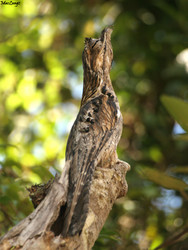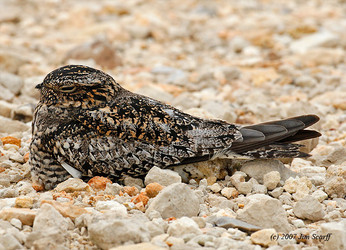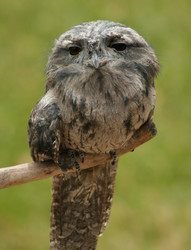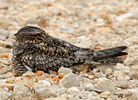Caprimulgiformes
Nightbirds



This tree diagram shows the relationships between several groups of organisms.
The root of the current tree connects the organisms featured in this tree to their containing group and the rest of the Tree of Life. The basal branching point in the tree represents the ancestor of the other groups in the tree. This ancestor diversified over time into several descendent subgroups, which are represented as internal nodes and terminal taxa to the right.

You can click on the root to travel down the Tree of Life all the way to the root of all Life, and you can click on the names of descendent subgroups to travel up the Tree of Life all the way to individual species.
For more information on ToL tree formatting, please see Interpreting the Tree or Classification. To learn more about phylogenetic trees, please visit our Phylogenetic Biology pages.
close boxReferences
Barrowclough, G. F., J. G. Groth and L. A. Mertz. 2006. The RAG-1 exon in the avian order Caprimulgiformes: Phylogeny, heterozygosity, and base composition. Molecular Phylogenetics and Evolution 41:238-248
Dumbacher, J. P., T. K. Pratt, and R. C. Fleischer. 2003. Phylogeny of the owlet-nightjars (Aves: Aegothelidae) based on mitochondrial DNA sequence. Molecular Phylogenetics and Evolution 29 (3): 540-549.
Fidler, A. E., S. Kuhn, and E. Gwinner. 2004. Convergent evolution of strigiform and caprimulgiform dark-activity is supported by phylogenetic analysis using the arylalkylamine N-acetyltransferase (Aanat) gene. Molecular Phylogenetic and Evolution 33 (3): 908-921.
Holyoak, D. 2001. Nightjars and Their Allies: The Caprimulgiformes. Bird Families of the World. Oxford University Press, Oxford, New York.
Iwaniuk, A. N., P. L. Hurd, and D. R. W. Wylie. 2006. The comparative morphology of the cerebellum in caprimulgiform birds: Evolutionary and functional implications. Brain Behavior and Evolution 67 (1): 53-68.
Lane, J. E., D. L. Swanson, R. M. Brigham, and A. E. McKechnie. 2004. Physiological responses to temperature by Whip-poor-wills: More evidence for the evolution of low metabolic rates in Caprimulgiformes. Condor 106 (4):921-925.
Larsen, C., M. Speed, N. Harvey and H. A. Noyes. 2007. A molecular phylogeny of the nightjars (Aves: Caprimulgidae) suggests extensive conservation of primitive morphological traits across multiple lineages
Molecular Phylogenetics and Evolution 42:789-796.
Mariaux, J. and M. J. Braun. 1996. A molecular phylogenetic survey of the nightjars and allies (Caprimulgiformes) with special emphasis on the potoos (Nyctibiidae). Molecular Phylogenetics and Evolution 6 (2):228-244.
Martin, G. R., L. M. Rojas, Y. M. R. Figueroa, and R. McNeil. 2004. Binocular vision and nocturnal activity in oilbirds (Steatornis caripensis) and pauraques (Nyctidromus albicollis): Caprimulgiformes. Ornitologia Neotropical 15:233-242. Suppl. S.
Mayr, G. 2001. Comments on the osteology of Masillapodargus longipes MAYR 1999 and Paraprefica major MAYR 1999, caprimulgiform birds from the Middle Eocene of Messel (Hessen, Germany). Neues Jahrbuch für Geologie und Paläontologie Monatshefte 2:65-76.
Mayr, G. 2002. Osteological evidence for paraphyly of the avian order Caprimulgiformes (nightjars and allies). Journal für Ornithologie 143 (1):82-97.
Mayr, G. 1999. Caprimulgiform birds from the Middle Eocene of Messel (Hessen, Germany). Journal of Vertebrate Paleontology 19 (3):521-532.
Rojas, L. M., Y. M. Ramirez, G. Marin, and R. McNeil. 2004. Visual capability in Caprimulgiformes. Ornitologia Neotropical 15: 251-260. Suppl. S.
Rojas, L. M., Y. M. Ramirez, R. McNeil, M. Mitchell, and G. Marin. 2004. Retinal morphology and electrophysiology of two caprimulgiformes birds: The cave-living and nocturnal oilbird (Steatornis caripensis), and the crepuscularly and nocturnally foraging common pauraque (Nyctidromus albicollis). Brain Behavior and Evolution 64 (1):19-33.
Strahan, R. , ed. 1994. Cuckoos, Nightbirds and Kingfishers of Australia. The National Photographic Index of Australian Wildlife. Angus and Robertson.
Title Illustrations

| Scientific Name | Nyctibius griseus |
|---|---|
| Specimen Condition | Live Specimen |
| Source | urutau |
| Source Collection | Flickr |
| Image Use |
 This media file is licensed under the Creative Commons Attribution-NonCommercial-ShareAlike License - Version 2.0. This media file is licensed under the Creative Commons Attribution-NonCommercial-ShareAlike License - Version 2.0.
|
| Copyright | © 2005 Martha Lange |
| Scientific Name | Chordeiles minor |
|---|---|
| Location | Anahuac National Wildlife Refuge, Texas, USA |
| Specimen Condition | Live Specimen |
| Source | Common nighthawk |
| Source Collection | Flickr |
| Copyright |
© 2007 Jim Scarff

|
| Scientific Name | Podargus strigoides |
|---|---|
| Location | Tasmanian Devil Conservation Park (Near Port Arthur), Tasmania |
| Specimen Condition | Live Specimen |
| Source | Tawney Frogmouth |
| Source Collection | Flickr |
| Image Use |
 This media file is licensed under the Creative Commons Attribution-NonCommercial License - Version 2.0. This media file is licensed under the Creative Commons Attribution-NonCommercial License - Version 2.0.
|
| Copyright | © 2007 Adam Tibballs |
About This Page
Page copyright © 2007
 Page: Tree of Life
Caprimulgiformes. Nightbirds.
The TEXT of this page is licensed under the
Creative Commons Attribution-NonCommercial License - Version 3.0. Note that images and other media
featured on this page are each governed by their own license, and they may or may not be available
for reuse. Click on an image or a media link to access the media data window, which provides the
relevant licensing information. For the general terms and conditions of ToL material reuse and
redistribution, please see the Tree of Life Copyright
Policies.
Page: Tree of Life
Caprimulgiformes. Nightbirds.
The TEXT of this page is licensed under the
Creative Commons Attribution-NonCommercial License - Version 3.0. Note that images and other media
featured on this page are each governed by their own license, and they may or may not be available
for reuse. Click on an image or a media link to access the media data window, which provides the
relevant licensing information. For the general terms and conditions of ToL material reuse and
redistribution, please see the Tree of Life Copyright
Policies.
- First online 14 December 2005
- Content changed 04 June 2007
Citing this page:
Tree of Life Web Project. 2007. Caprimulgiformes. Nightbirds. Version 04 June 2007 (temporary). http://tolweb.org/Caprimulgiformes/56965/2007.06.04 in The Tree of Life Web Project, http://tolweb.org/











 Go to quick links
Go to quick search
Go to navigation for this section of the ToL site
Go to detailed links for the ToL site
Go to quick links
Go to quick search
Go to navigation for this section of the ToL site
Go to detailed links for the ToL site